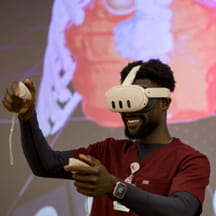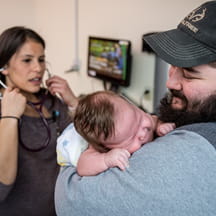As artificial intelligence (AI) becomes more accessible, it will play an increasingly significant role in pediatric medicine, including research, education and training, and clinical practice. While an important part of AI’s enormous potential is relieving human workers of time-consuming, manual tasks, it also may require new kinds of staff: those who can program and manage the complex technology.
Last year, Boston Children's Hospital hired Dinesh Rai, MD, as its first-ever prompt engineer — a job involving designing inputs (prompts) for generative AI tools to produce specific, high-quality outputs.
But as the technology rapidly evolves, so does Rai’s role with Boston Children's. “As these models get better, it's less about actual prompt engineering. The need for very detailed specific prompts has lessened over time,” said Rai, AI engineer at Boston Children’s Innovation and Digital Health Accelerator. “My focus has been more about determining how to fit these large language models into a pipeline and fitting those pipelines together — essentially creating these products from scratch.”
Freeing up clinicians’ time
Rai, an emergency medicine physician, said the use cases for these types of products are “endless,” but currently his efforts focus on two areas:
- Developing AI chat applications for medical education and training.
- Using the models to perform a specific task, often in the background without the need for user interaction. For example, an AI model may continuously analyze scores of medical notes for certain text or themes in a patient’s medical history and instantly present a patient’s primary diagnosis to a clinician — without the need for laborious manual research.
Prioritizing use cases for deploying the technology is a team effort, according to Rai. But he said time-consuming tasks that AI models can accomplish rapidly — such as finding a single piece of text in a lengthy document — are the most logical places to begin.
The driving influence is increasing workflow efficiencies while easing clinician burnout. “Our aim is to give them more time to think about strategy or do more higher-level things and reduce the burden of those tedious small tasks,” Rai said.
Working behind the scenes
When Rai mentions pipelines, he's talking about setting up prompts to run automatically in the background to make existing systems smarter. These background tasks limit the AI's role to a specific, controlled task with predefined outputs, reducing the chance of unexpected or inappropriate responses. Additionally, since there's no direct user interaction, it minimizes potential misuse or overreliance on AI-generated information in critical decision-making processes.
For example, imagine an email system for customer help requests. AI can sort these emails automatically using auto-generated prompts, like this:
- Customer emails come in
- Email is sent in a prompt to a large language model (like ChatGPT) with the question "Which department for this: 'finance', 'legal', 'HR', or 'IT'?"
- The LLM outputs one of those choices
- Email gets sent to that department
No one's chatting with the AI here, but the chatbot is performing the specific job with set options. The output is controlled and easily verifiable — as in, it is simple to check if there is anything in the LLM output other than those options, or if the email was sent to the wrong department.
Finding the right fit
For this position, Boston Children’s sought someone with a background in both medicine and technology. As an emergency room physician and a developer of successful AI applications, Rai fit the bill. He said having experience in both realms is very useful in his role and would recommend children’s hospitals seek others with dual capabilities when looking to create similar positions.
Being an AI engineer who understands medicine means faster iteration cycles; Rai doesn’t need to wait for a clinician to verify that a new model appropriately serves the medical team’s needs. And it gives him a unique perspective when devising use cases.
“Understanding how the model can be used and how that pipeline could fit into a clinical process, I can consider things that other people may not think about if they have only the clinical background or only the technological background,” Rai said.
Tips for a successful AI strategy
Other items to consider when embarking on an AI strategy:
- Start small. “Pick simpler use cases to begin; just focus on what can be automated before planning a grand strategy,” Rai said.
- Empower staff. Encouraging team members to think more holistically about their day-to-day work can lead to projects that automate menial tasks for everyone.
- Experiment rapidly. With the advancement of machine learning technology, it’s no longer necessary to accumulate thousands of examples and commit substantial resources to training an AI model, Rai said. Testing quickly and frequently will move automation — and the benefits it brings to health care providers — forward with greater speed.


